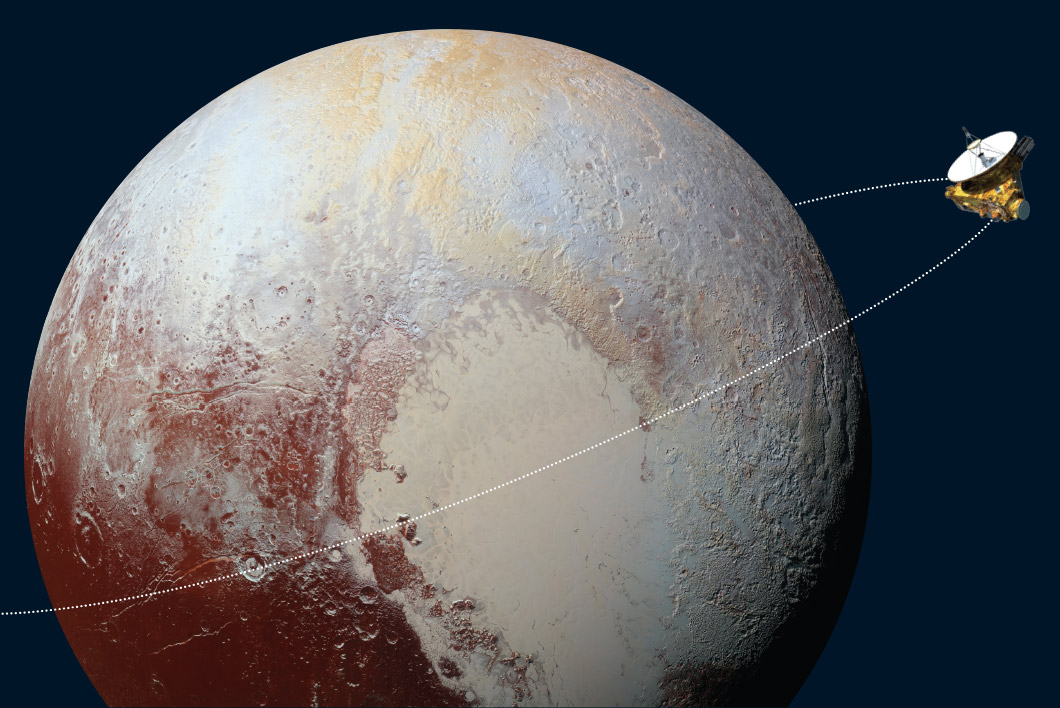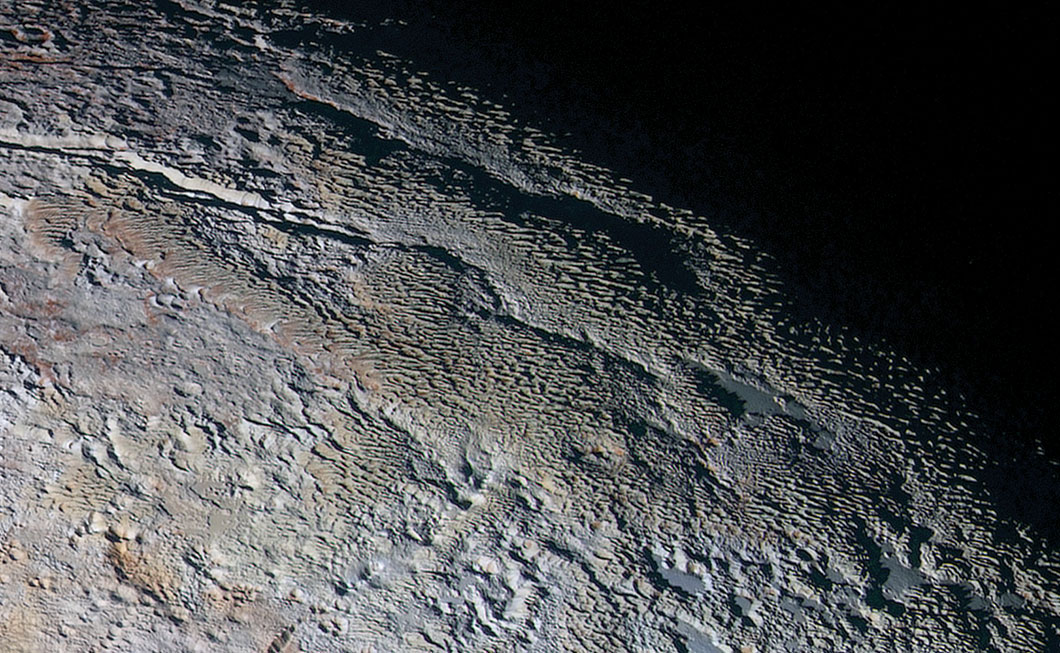Collaboration
What’s Over the Horizon?
With a little help from Mudders, New Horizons has begun to unlock the mysteries of the farthest worlds ever explored by humankind.
AS HARVEY MUDD STUDENTS SETTLED INTO THEIR dorms to start the 2009–2010 academic year—some a tad homesick no doubt—Pluto-bound spacecraft New Horizons was also far from home, continuing its 9.5-year, three-billion-mile interplanetary traverse from Cape Canaveral to the outer reaches of the solar system, hurtling through the starry void at 51,000 miles per hour, somewhere between Saturn and Uranus.
Back on Earth, the Southwest Research Institute (SwRI) Clinic team was busy optimizing code. Predominantly engineers, they were tasked with improving execution time and output quality of an optimal image subtraction algorithm—software important to the study of Pluto and the distant Kuiper Belt, to which Pluto serves as gateway. The Kuiper Belt represents a third zone of our solar system, chock full of Pluto-like dwarf planets and other novel celestial objects—all potential extended- mission targets for New Horizons.

Seniors Austin Lee, Chris Sauro and Florian Scheulen, along with juniors Steven Berry, Cullen McMahon and Claire Robinson, had little inkling their work would come to play a crucial role in one New Horizons astronomer’s ongoing planetary research. And of course they had no idea where they’d be come July 15, 2015, the day scientists calculated New Horizons’ arrival at Pluto’s system— or that their Clinic project would play such a crucial role.
Space for the Stars
The 2009–2010 SwRI Clinic team was given two tasks. First they sought to help astronomers better isolate images of Pluto and other Kuiper Belt Objects (KBOs) within dense star fields. Under the advisement of engineering Professor Patrick Little, the team began optimization on a previously existing imaging algorithm designed to account for differences in nearly identical astronomical images due to changes in atmospheric conditions. Matching like qualities between images and then subtracting them eliminates fixed objects from the frame to provide less cluttered images.
“The tricky part was getting the images from different nights to match, both in terms of aligning them as well as accounting for varying atmospheric conditions,” recalls Lee, now an engineer at Oracle Labs. “To add difficulty, these objects are very hard to detect in the first place, and the search space is truly enormous. A computational approach is absolutely required.”
While the previous code functioned well, its execution time was glacial. SwRI needed a much faster algorithm to complete ground-based telescopic research for New Horizons’ extended-mission target as well as for ongoing photometry of Pluto.
“A major focus of the project was to take that package that already existed but was excruciatingly slow to run,” says Marc Buie, SwRI Clinic liaison and New Horizons astronomer. “I gave them the code, and they dove into it. They had to learn how it worked, build tools for validating whether it was working and speed it up.”
This last part the team found daunting.
“I remember running initial software tests before we made any changes,” says Robinson, who now performs data-link at Honeywell. “It took hours to process a 600-by-600-pixel image, and Marc was hoping to analyze 60,000-by-60,000-pixel images.” Such an improvement would allow ground-based telescopes to capture Pluto images of previously unattainable clarity.
Ultimately the optimization succeeded, with noticeable improvement to image-processing quality at each step. Further, by the end of first semester, the team had sped up the process by a factor of 1,000. Rather than taking the better part of a day to process a pair of images, it now took only seconds.
“Without their work, I couldn’t use this tool,” says Buie. “We’re talking about terabytes worth of data to process. Without being able to run this on a finite time scale, New Horizons would have passed Pluto long before we finished our research.”
Their optimization work remains hugely valuable for ground-based study, says Buie, who continually observes Pluto against a complicated background of stars to monitor the long-term brightness of its surface. It’s also aided him in ground-based photometry aimed at detecting new satellites and rings around Pluto.
Moving Target
The team’s second task was to locate potential extended-mission KBO targets for New Horizons. However, problems with image processing, as well as the sheer enormity of the project, made this impossible.
“To be honest, I was a little disappointed after the project was over, because we failed one of the key requirements: finding a KBO,” says Scheulen, now a structures engineer for SpaceX. “Now I realize that it was just a task too big for us to manage.”
Instead, the group found itself devising Dewarp, an image-registration program designed to reduce camera distortion.
“Before you can do image subtraction and run the OIS code that they optimized, you actually have to register the two images together,” explains Buie. “Every time you take a picture, the telescope might not be pointed in the exact same spot, stars have shifted a little bit and, furthermore, the cameras that we’re using have some distortion in the optics.”
Even the tiniest pixel shifts might cause optical distortion. The team’s “misregistration” problem required a program that could resample the images onto a perfect grid, upon which they could control image alignment and scale by stacking them rectilinearly. Dewarp provided this capability and decreased differential distortion.
“All the software I wrote as part of the [New Horizons] navigation team included things learned from the tools we wrote for ground-based research, including the Dewarp program,” says Buie. “It is a fundamentally important tool in my arsenal and is at the heart of almost everything that I was doing to support the [New Horizons] mission.”
Buie also used Dewarp to search for hazards in New Horizons’ trajectory, including potentially disastrous dust particles. “Imagine a grain of rice broken into three pieces,” says Buie. “One of those pieces, if the craft hit it, would be lethal. We were looking with both Hubble Space Telescope and on-board cameras as New Horizons approached [Pluto].”

Grateful to Students
A founding member of the “Pluto Underground”—a dozen planetary scientists who devoted decades of research and advocacy to push Pluto exploration to the top of NASA’s agenda—Buie has studied the planet since the early 1980s, developing a compelling case for Pluto as the next frontier of space exploration. And throughout that research, he says, student collaboration has been key.
“I’ve involved students every step of the way,” he says, “mostly undergraduate and summer research projects through the NSF’s [Research Experiences for Undergraduates] Program. I was very keen to give HMC Clinic a try.” Though the team never got to explore extended-mission targets as the original Clinic project called for (the Hubble Space Telescope was required for this enormous undertaking), they provided an invaluable technical boost.
“They broke the logjam of difficulty I was having with the software—not being able to read and get this stuff processed,” says Buie. “It gave me the next generation of tools I needed to tackle the problems.”
“I don’t think I fully realized how impactful [the work] would really be,” says Scheulen. “I wasn’t aware of how many people and organizations were involved in the project, or that Marc would be able to use our code for so many additional applications.”